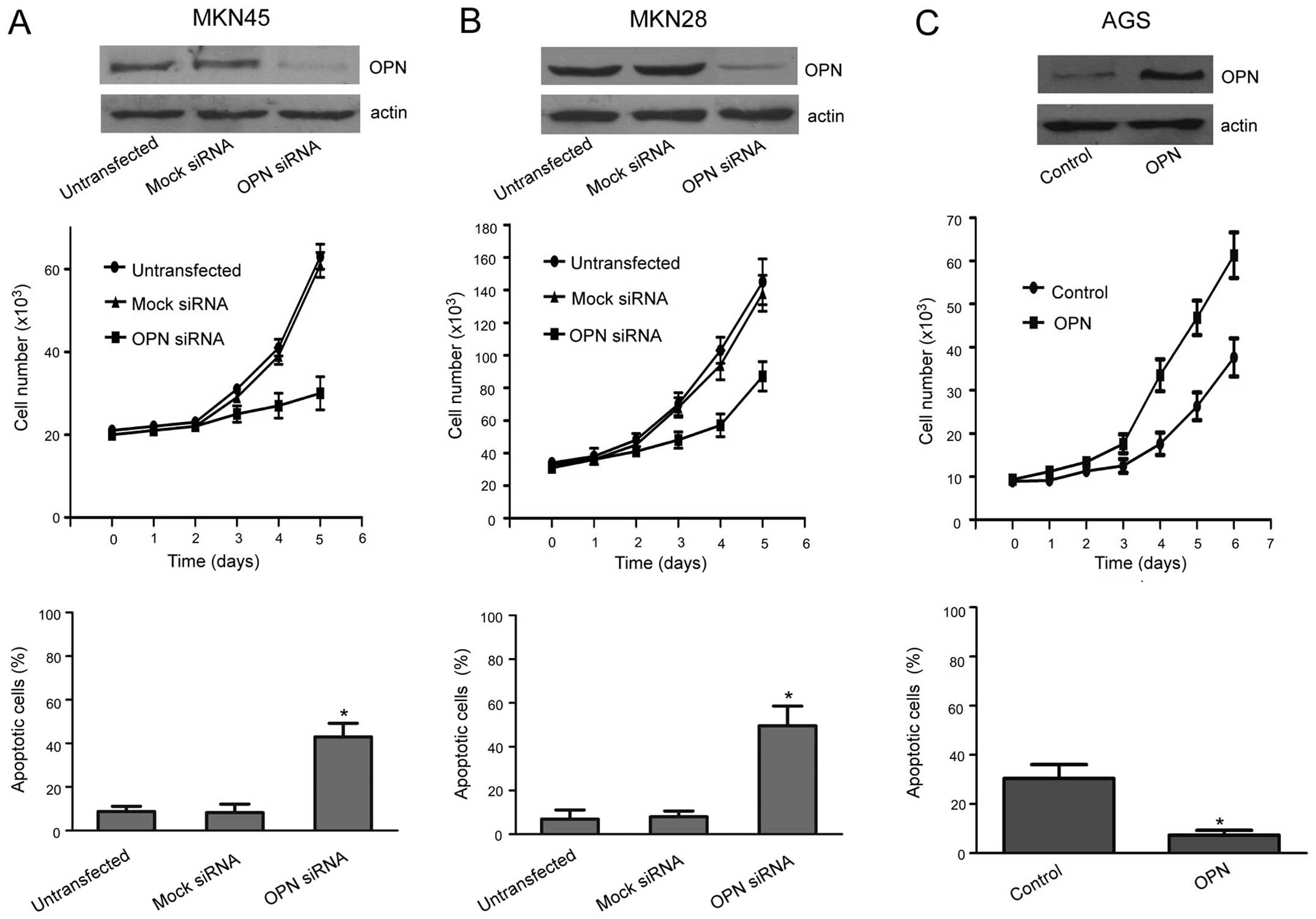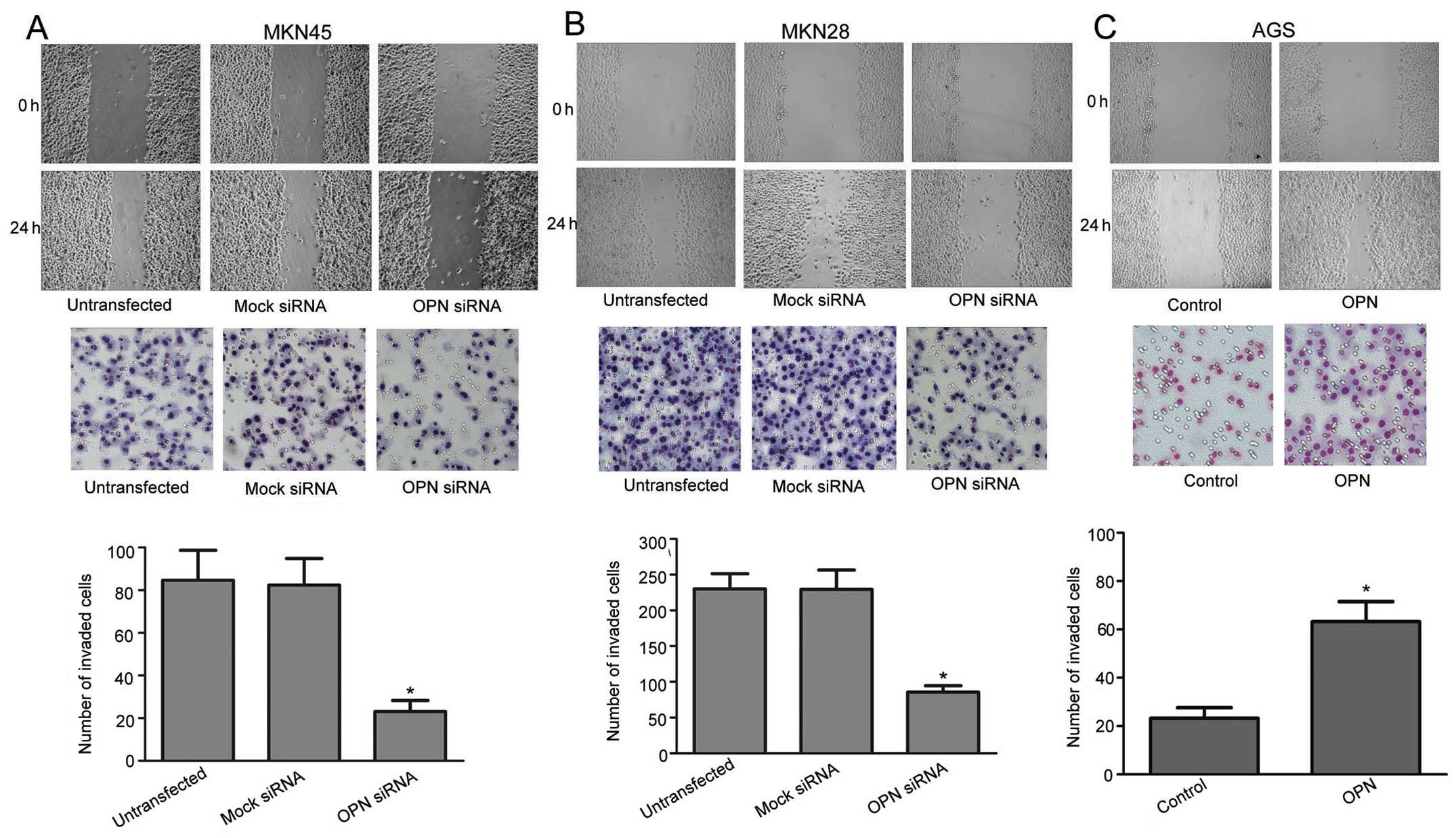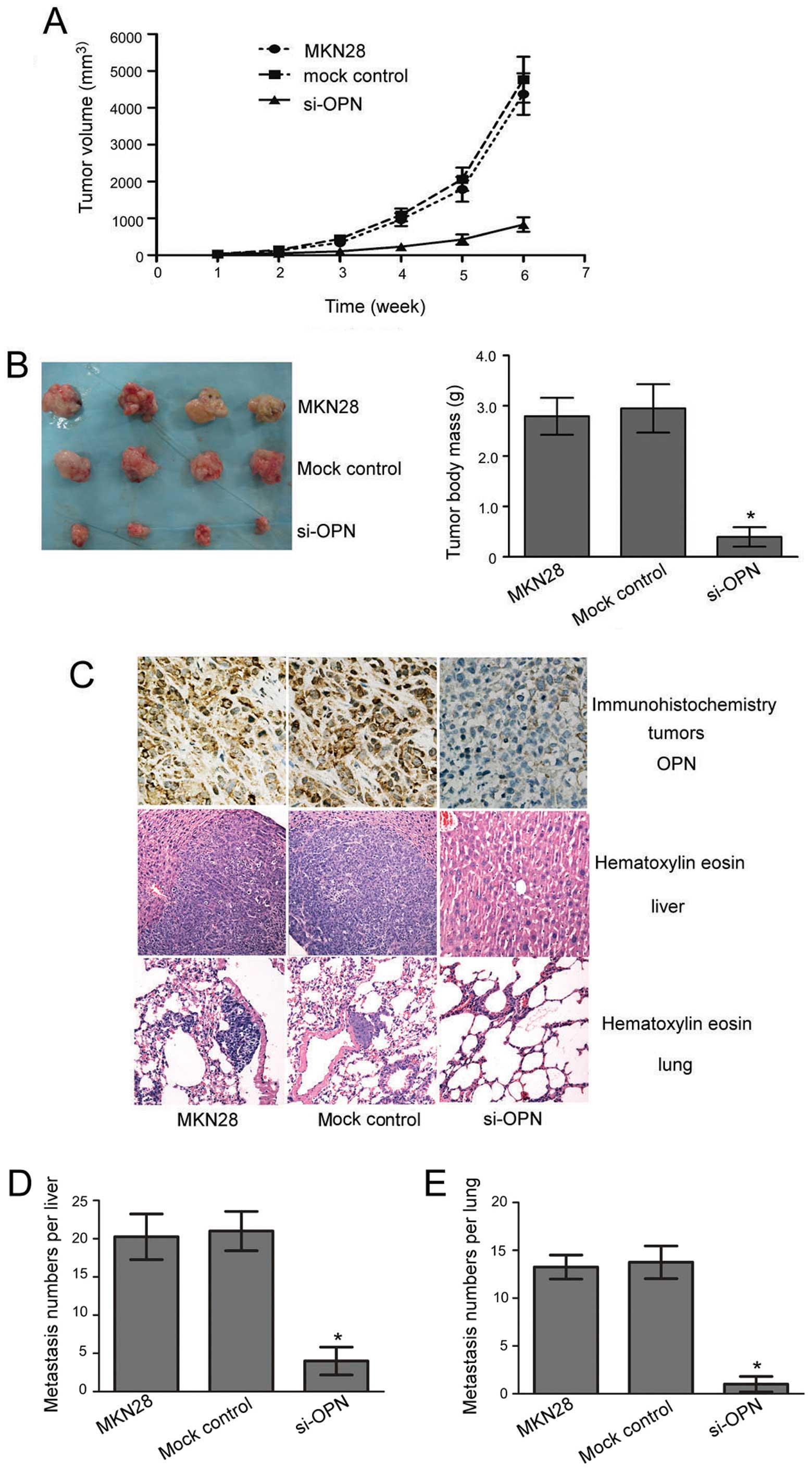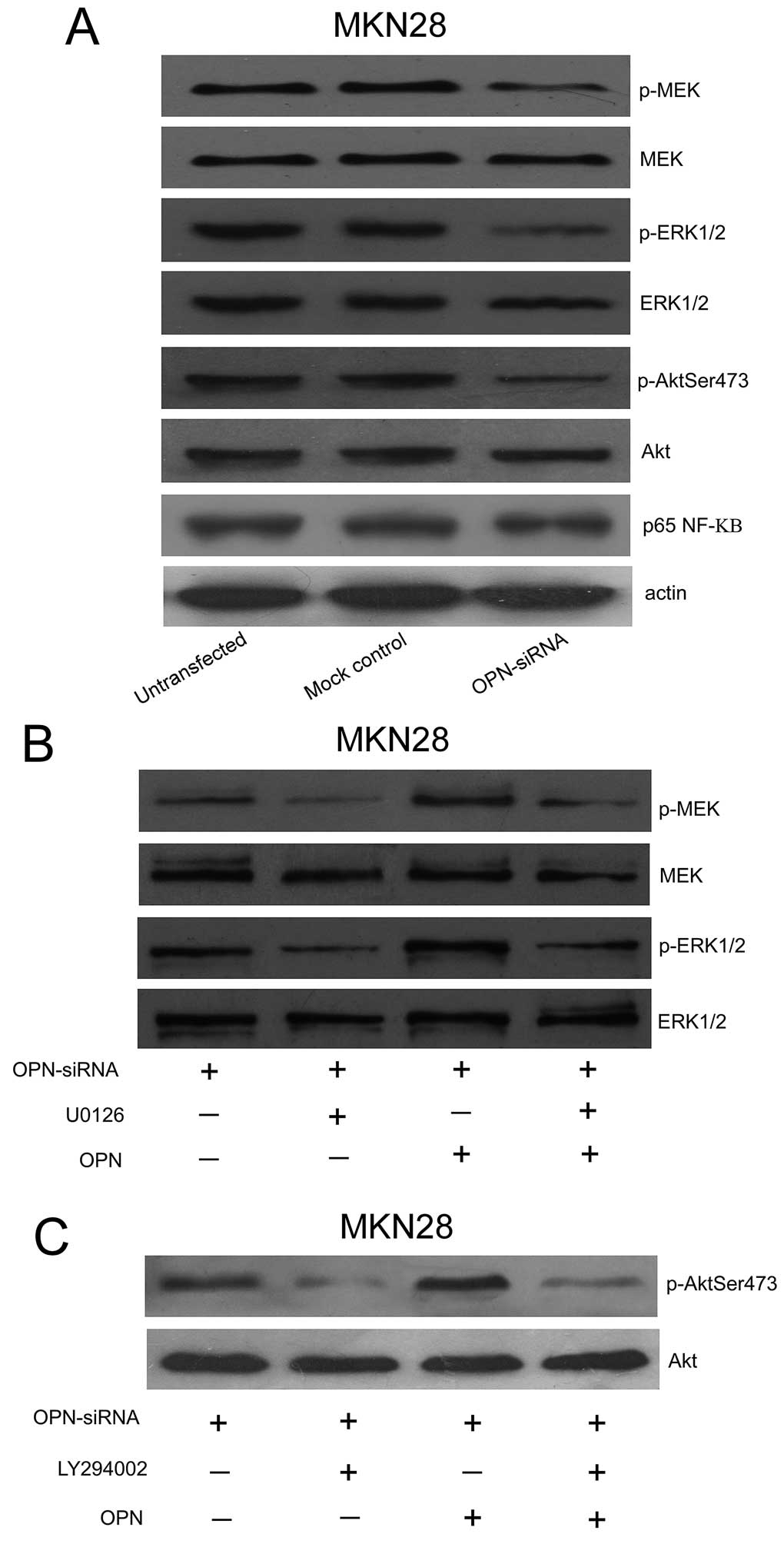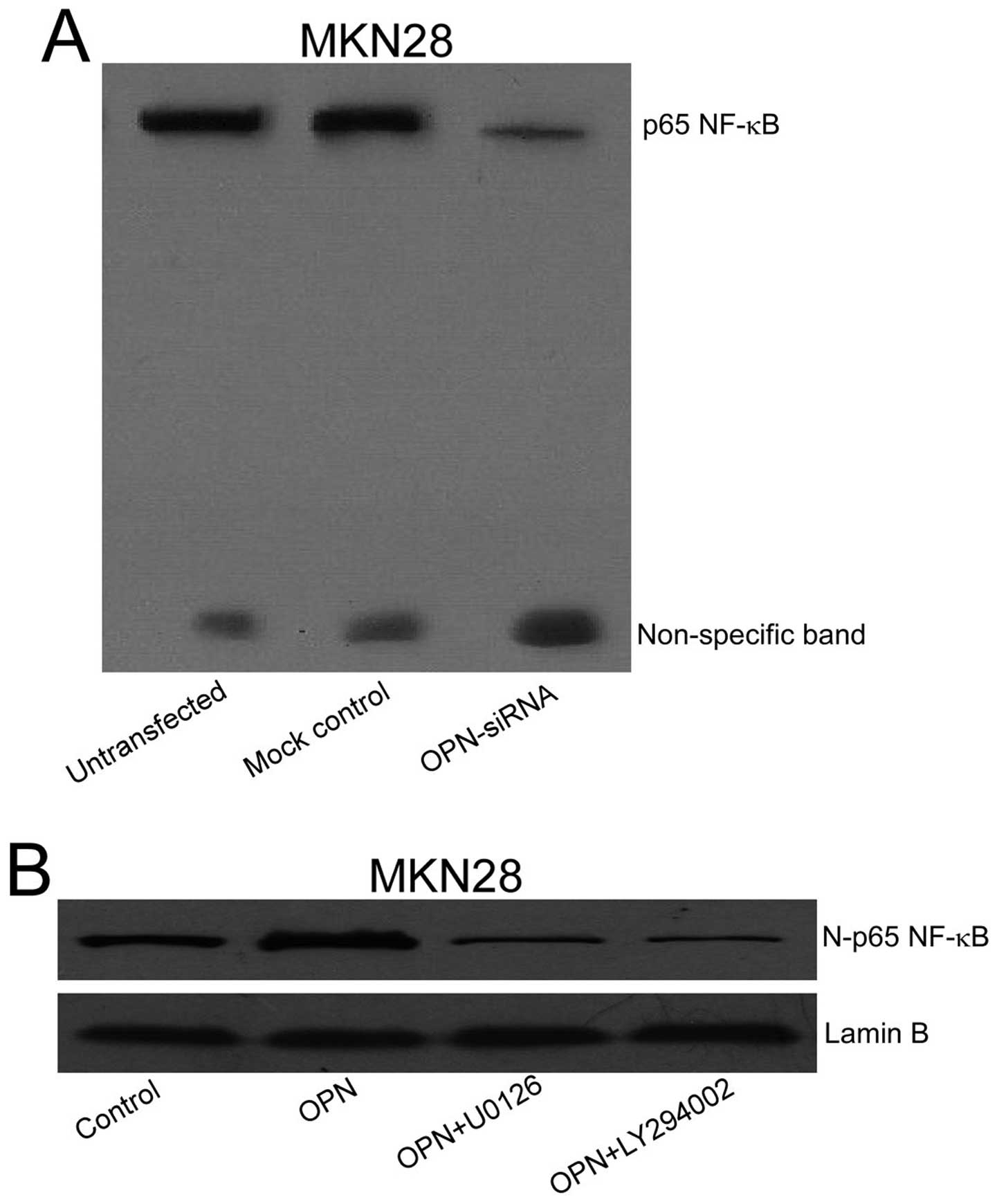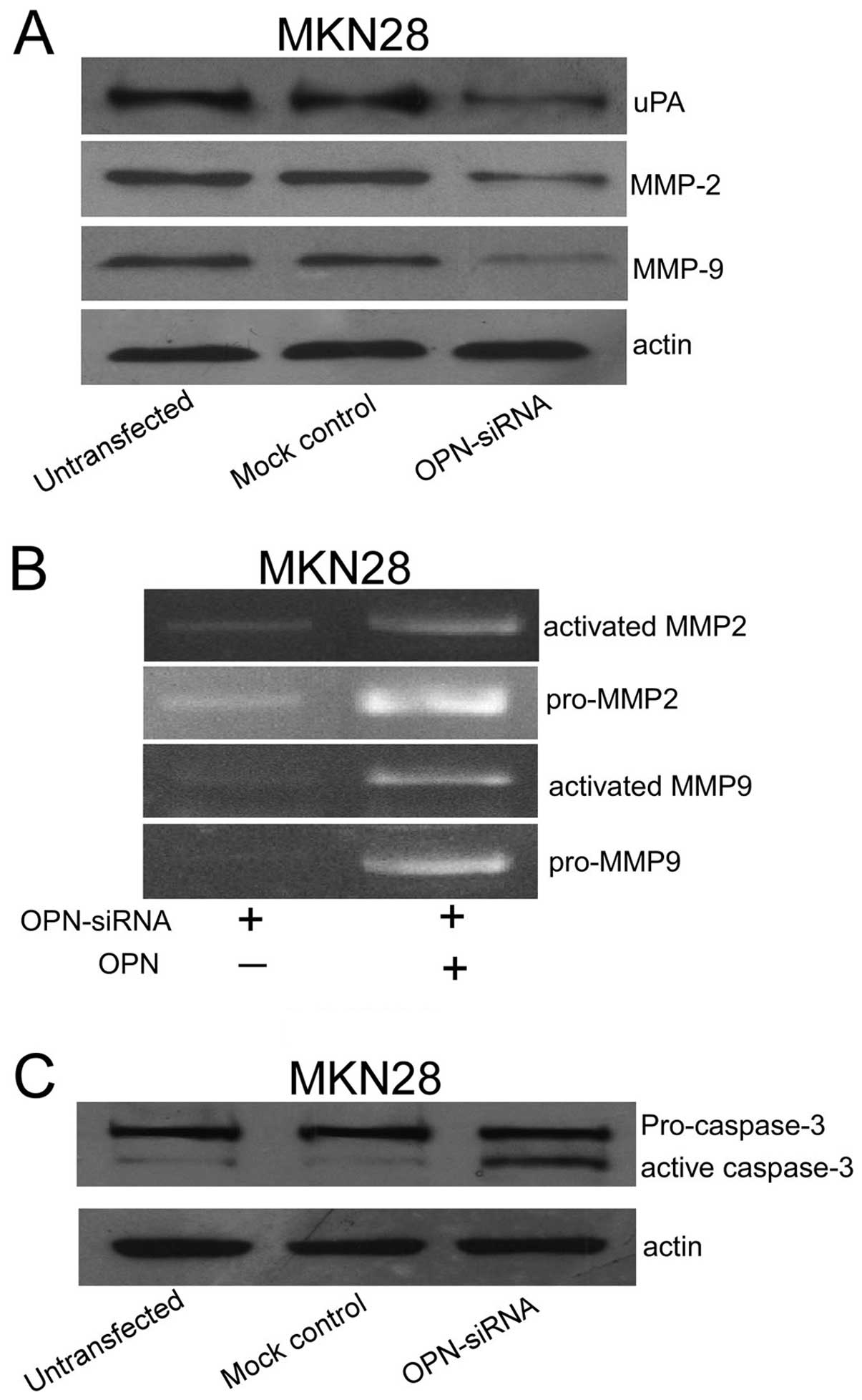Osteopontin promotes the progression of gastric cancer through the NF-κB pathway regulated by the MAPK and PI3K
- Authors:
- Published online on: April 17, 2014 https://doi.org/10.3892/ijo.2014.2393
- Pages: 282-290
Abstract
Introduction
Osteopontin (OPN) is a secretory extracellular matrix phos-phoglycoprotein that was originally identified in bone tissue and is vital to control biomineralization, osteoclast differentiation and bone resorption (1). They are expressed by cancer cells as well, and participate in various metastasis-associated mechanisms including proliferation, survival, adhesion, migration, invasion, angiogenesis, malfunction of tumor-associated macrophages (TAMs) and degradation of extracellular matrix (2–4).
Previous studies have shown that, in gastric cancer tissues, OPN protein is diffusely located in the cytoplasm of tumor cells as well as TAMs, which is in line with its implications in the interactions between cancer cells and tumor stroma (5). Over the past decade, emerging evidence has revealed a correlation of OPN overexpression and clinicopathological features and prognosis in gastric cancers, indicating its potential diagnostic and prognostic values in such patients (6,7). Functional studies suggest that targeting OPN and its related signaling network is likely to provide an effective therapeutic approach for gastric cancers in vitro and in vivo (8–10). Due to the importance of OPN in gastric cancer, better understanding of the implications of OPN in tumorigenesis might facilitate development of therapeutic strategies in such patients.
In this study, we investigated the biological functions of OPN proteins in gastric cancer in vitro and in vivo. The molecular events that define the role of OPN in gastric cancer metastasis were investigated. We found that the OPN status affected proliferation, apoptosis, invasion and migration of gastric cancer in vitro, and OPN silencing decreased tumor growth and metastasis in vivo. We also demonstrated that OPN signaling, acting through the mitogen-activated protein kinase (MAPK), phosphoinositide 3-kinase (PI3K)/protein kinase B (Akt) and p65 nuclear factor κB (NF-κB) pathways, may contribute to cancer processes by inducing matrix metalloproteinase 2 (MMP-2), MMP-9 and urokinase-type plasminogen activator (uPA) activity, and inhibiting caspase-3 cleavage.
Materials and methods
Cell lines
The human gastric cancer cell lines SGC7901, GES-1, AGS, MKN45 and MKN28 were bought from the China Center for Type Culture Collection (Wuhan, China). Cells were routinely maintained in RPMI-1640 medium (Gibco, Grand Island, NY, USA) supplemented with 10% fetal bovine serum (FBS) and 100 U/ml penicillin/streptomycin at 37°C. The cells were cultured on tissue culture dishes coated with 10 mg/ml fibronectin.
Animals
Four- to 6-week-old female/male athymic BALB/c nu/nu mice were obtained from the Central Laboratory of Animal Science at Wuhan University (Wuhan, China) and housed in laminar-flow cabinets under specific pathogen-free conditions, with food and water ad libitum. All experiments on mice were conducted in accordance with the guidelines of National Institutes of Health (NIH; Bethesda, MD, USA) for the care and use of laboratory animals. The study protocol was also approved by Shanghai Medical Experimental Animal Care Committee (China).
Lentivirus vector construction and infection
Small interfering RNA (siRNA; GeneChem, Shanghai, China) against OPN (GenBank accession no. NM_000582) mediated by lentivirus and its mismatch mutants as negative control were designed using an Internet application system (Invitrogen, Carlsbad, CA, USA). These target sequences tagged with green fluorescent protein (GFP) were annealed and inserted into pGC-LV expression vector (Invitrogen), and then cotrans-fected into 293FT cells with packaging vectors (pHelper 1.0 and pHelper 2.0; Invitrogen) using Lipofectamine 2000 (Invitrogen). After a 48-h incubation period post transfec-tion, viral supernatants were collected, concentrated, and stored at −70°C. MKN45 and MKN28 cells were infected with OPN-specific siRNA lentivirus or control lentivirus with a multiplicity of infection (MOI) from 5 to 20 in the presence of polybrene (10 mg/ml), respectively.
Growth curves
The cells were plated in 96-well plates and maintained at 37°C in a humidified incubator. The cells were harvested by trypsinization every day for 5 or 6 days and counted with a hemocytometer.
Apoptosis assay
Cells were suspended at each chosen time-point. Cells (2×106) were then centrifuged and washed twice with ice-cold phosphate-buffered saline (PBS). Apoptotic cells were detected by flow cytometric analysis using Annexin-V fluorescein and propidium iodide (PI) (Molecular Probes, Invitrogen, Eugene, OR, USA).
Invasion assay
Transwell invasion chambers (Millipore Corp., Bedford, MA, USA) consisting of a thin layer of Matrigel basement membrane matrix were used. The upper surface of filters was 6.4 mm in diameter with 8-μm pores. In the upper chambers, 1×105 cells in 200 μl of serum-free medium was added. Then, 500 μl of RPMI-1640 medium containing 20% fetal calf serum was added to the lower chambers as a chemoattractant. After incubation for 24 h at 37°C in a humid atmosphere of 5% CO2 and 95% air, the cells that had invaded through the membrane and had reached the lower surface of the membrane were fixed with methanol and stained with hematoxylin. Photographs were taken and stained cells were counted under a microscope in five randomly chosen fields.
Migration assay
Cells were cultured in fibronectin-coated 6-well tissue culture plates as confluent monolayer. The near confluent cell monolayer was then carefully scratched using 20 μl sterile pipette tips. Cell debris was removed by washing with PBS. The dishes were incubated in fresh regular culture medium containing hydroxyurea (2 mM) for additional 24 h and photographs were taken under a light microscope.
Western blotting
Proteins were extracted from the cultured cells and then quantitated. Equal amounts of protein (30 /Ag) from different cells were separated by a 10% SDS-polyacrylamide gel, transferred onto nitrocellulose paper (Millipore, Billerica, MA, USA) and then incubated overnight at 4°C with a 1 μg/ml of antibody against target proteins. Protein bands were detected by the enhanced chemiluminescence (ECL) kit (Pierce, Rockford, IL, USA) and exposure to Biomax ML film (Eastman Kodak, Rochester, NY, USA). The primary antibodies against mitogen-activated protein kinase (MEK), phosphorylated MEK (p-MEK), extracellular signal-regulated kinase 1/2 (ERK1/2), p-ERK1/2, Akt, p-Akt (Cell Signaling Technology, Danvers, MA, USA), MMP-2, MM-9, uPA, p65 NF-κB, Caspase-3, lamin B and actin (Santa Cruz Biotechnology, Santa Cruz, CA, USA) were used.
Electrophoretic mobility shift assay
Electrophoretic mobility shift assay (EMSA) was performed using an EMSA Gel-Shift kit (Pierce). Nuclear extracts were prepared and incubated with NF-κB-32P-labeled oligonucleotide (5′-AGCTATGTG GGTTTTCCCATGAGC-3′) for 30 min at room temperature. Samples were electrophoresed at 100 V and 4°C, transferred to Biodyne nylon membranes (Pierce), and then cross-linked in an ultraviolet cross-linker (Stratagene Inc., La Jolla, CA, USA). Gels were visualized using streptavidin-HRP followed by chemiluminescence detection.
Gel zymography
The medium was collected to concentrate using Centricon centrifugal filters devices with YM-30 membranes (Millipore) and the protein concentration was detect using Bio-Rad assay. Protein (10 μg) was loaded onto zymographic sodium dodecyl sulfate gel containing gelatin (1 mg/ml). The gels were washed twice in 2.5% (v/v) Triton X-100 at room temperature before incubation in 50 mM Tris-HCl (pH 7.6), 10 mM CaCl2, 50 mM NaCl and 0.05% Brij35 overnight at 37°C. The gels were stained with 0.5% Coomassie brilliant blue R-250 for ≥1 h and destained with methanol/acetic acid to reveal zones of gelatinase activity. The gels were analyzed using the Typhoon™ 9400 Scanner (GE Healthcare). Image quantification was performed using ImageQuant ™ TL software (GE Healthcare).
In vivo tumor growth assay
Nude mice were divided into three groups, six mice in each group. To evaluate in vivo tumor growth, 1×107 OPN silencing cells, mock virus-transfected cells or untransfected cells (MKN28) were injected subcu-taneously into the nude mice. Tumor growth was monitored with tumor volume, which was calculated as follows: V (mm3) = width2 (mm2) × length (mm)/2. The mice were sacrificed 6 weeks later, and tumors were harvested. The tumor weight was recorded.
In vivo metastasis assays
Nude mice were injected subcutane-ously with 1×107 OPN silencing cells, mock virus-transfected cells or untransfected cells (MKN28). After 15 days, the tumors were extirpated. Cancer tissue was divided into small pieces, ∼1 mm in diameter, for stomach surgical orthotopic implantation. During surgical implantation, a small area of the gastric serosa was removed, and 1 mm3 tumor fragment per mouse was implanted. Tumor pieces were penetrated and sutured to the gastric wall by a nylon surgical suture. Two months later, all the mice were sacrificed, individual organs were excised, and metastases were checked by hematoxylin-eosin (H&E) staining. The incidence and classification of metastasis were calculated and evaluated independently by two pathologists.
Statistical analysis
For statistical evaluation of cell culture experiments, mean values and standard deviation of at least triplicate experiments were calculated. Student’s t-test was used to compare the difference of mean values. Difference in the incidence of liver and lung metastasis was analyzed by Fischer’s exact test. P-values <0.05 were defined as statistically significant.
Results
Expression levels of OPN in gastric cancer cell lines
As shown in Fig. 1, the expression levels of OPN in MKN45 and MKN28 cell lines were much higher than that in SGC7901 and GES-1 cells, while the lowest level of OPN among the 5 gastric cancer cells tested was in AGS cells. Therefore, MKN45, MKN28 and AGS cells were selected and used in the following experiments.
OPN status affects proliferation and apoptosis of gastric cancer cells in vitro
OPN expression was inhibited in MKN45 and MKN28 cells which had higher expression levels of OPN, and OPN expression was upregulated in AGS cells which slightly expressed OPN. First, OPN expression was inhibited in MKN45 and MKN28 cells by transfection with OPN-specific siRNA for 24 h. OPN silencing significantly inhibited proliferation and promoted apoptosis in both cell lines compared with the control (P<0.05, OPN silencing relative to untransfected or mock control, Fig. 2A and B). Then, OPN expression was upregulated in AGS cells by treatment with 10 μM exogenous recombinant OPN for 24 h. OPN significantly promoted proliferation and inhibited apoptosis in AGS cells (P<0.05, OPN upregulation relative to control, Fig. 2C). These data show that the OPN status strongly affects proliferation and apoptosis in gastric cancer cells.
OPN status affects invasion and migration of gastric cancer cells in vitro
Cell invasion and migration were analyzed as described in Materials and methods. OPN silencing significantly inhibited invasion and migration in MKN45 and MKN28 cells (P<0.05, OPN silencing relative to untransfected or mock control, Fig. 3A and B). OPN expression significantly promoted invasion and migration in AGS cells (P<0.05, OPN upregulation relative to control, Fig. 3C). Our findings suggest that the OPN status significantly affects invasion and migration in gastric cancer cells.
OPN siRNA inhibits gastric cancer xenograft growth in vivo
MKN28 (parental control), control lentivirus-infected cells (mock control) and OPN-specific siRNA lentivirus-infected cells (si-OPN) were subcutaneously implanted into nude mice, respectively. Tumor growth curves were plotted in the course of the experiment (Fig. 4A), and the weight of tumor was evaluated at 6 weeks post-inoculation (Fig. 4B). Obvious tumor masses could be found in the two control groups of mice inoculated with MKN28 cells (2.76±0.43 g) or mock control cells (2.97±0.52 g), while much smaller tumors were detected in the si-OPN groups (0.45±0.22 g) (P<0.05, si-OPN groups relative to mock control or MKN28 groups). These data suggest that the treatment of OPN siRNA blocked the growth of tumor compared to control groups, the parental or the mock-transfected groups. In addition, compared with the control groups, no significant body weight change or other toxicity was observed in the treatment groups (data not shown).
OPN siRNA inhibits gastric cancer xenograft metastasis in vivo
The effect of OPN silencing on tumor metastasis was further assayed in athymic mice. Autopsy was performed, and the incidence of metastasis in the livers, lungs and other organs was determined by macroscopic and histologic examinations. The incidence of hepatic metastasis in mice of the parental and the mock-transfected groups was 60% (6 of 10) and 70% (7 of 10), respectively. In the si-OPN groups, only 30% (3 of 10) of animals had hepatic metastasis (Fig. 4C). Pulmonary metastases were found in 30% (3 of 10) of the parental groups, 40% (4 of 10) of the mock-transfected groups and 10% (1 of 10) of the si-OPN groups (Fig. 4C). As shown in Fig. 4D, the numbers of hepatic metastatic lesions in the si-OPN groups (4.2±3.9) were greatly decreased compared with those in the mock-transfected (20±3.4) and the parental groups (21.5±3.1). The most lung metastases were observed in the mock-transfected (13.8±2.1) and the parental mice (14.5±2.6). Only a few lung metastases were observed in mice of si-OPN groups (2.5±1.6) (Fig. 4E). Moreover, their metastatic lesions were much smaller than those in the parental or mock control. The difference between the si-OPN groups with the parental or the mock transfected groups was significant (P<0.05).
OPN mediates the MAPK and PI3K signaling pathways in gastric cancer cells
To explore the possible mechanisms of OPN in progression of gastric cancer, the expression levels of NF-κB and activation of Akt and MEK/ERK1/2 were investigated in gastric cancer cells transfected with siRNA against OPN. Compared with untransfected or mock control, OPN siRNA was demonstrated to induce a significant decrease in the phosphorylation levels of Akt (Ser473), MEK and ERK1/2; however, no significant alteration in p65 NF-κB was observed in the cells transfected with OPN-specific siRNA (Fig. 5A).
To further evaluate the association of OPN with activation of MEK and ERK1/2, MKN28 cells were transfected with OPN siRNA, followed by incubation with OPN. Some of them were pretreated with specific MEK inhibitor, 4-diamino-2, 3-dicyano-1, 4-bis[2-aminophenylthio] butadiene (U0126) (20 μM), and those treated with OPN alone without pretreatment with U0126 were used as control. OPN was demonstrated to significantly increase the phosphorylation of MEK and ERK1/2, and U0126 could inhibit the activation of MEK and ERK1/2 induced by OPN (Fig. 5B).
In Fig. 5C, the si-OPN cells were treated with 10 μM exogenous recombinant OPN. Some of them were pretreated with specific Akt inhibitor 2-(4-morpholinyl)-8-phenyl-4H-1-benzopyran-4-one (LY294002) (25 μM), and those treated with OPN alone without pretreatment with LY294002 were used as control. It was found that Akt could be activated in OPN treated cells, and be inhibited in the cells pretreated with LY294002.
The MAPK and PI3K signaling pathways are involved in OPN-induced NF-κB activity in gastric cancer cells
To investigate the effect of OPN siRNA on p65 subunit of NF-κB, EMSA of NF-κB was performed. OPN siRNA was demonstrated to inhibit a translocation of p65 into nuclei in MKN28 cells. No significant alteration in NF-κB /DNA binding activity was found in the cells transfected with mock control (Fig. 6A).
To further determine how OPN affects this translocation, MKN28 cells were incubated with recombinant OPN for 90 min, some of the cells were preincubated with U0126 or LY294002 for 30 min. Cell lysates of nucleus were extracted and immunoblotted with antibodies specific to p65. Western blot analysis further confirmed the association of translocation of p65 with the OPN effects, and the effects of OPN on the p65 translocation in MKN28 cells were obviously inhibited by the MEK and Akt inhibitor, respectively (Fig. 6B). Taken together, we suggest these results show that MEK and Akt are partially mediated, OPN-induced the translocation of p65 from cytoplasm to the nuclei in MKN28 cells.
NF-κB signaling pathway mediates OPN-induced MMP-2, MMP-9 and uPA activity, and caspase-3 inhibition in gastric cancer cells
Western blotting was performed to investigate the expression levels of MMP-2, MMP-9 and uPA. The expression levels of MMP-2, MMP-9 and uPA were decreased in MKN28 cells treated with OPN siRNA (Fig. 7A). Then, gelatin zymography was used to investigate the activity of MMP-2 and MMP-9. OPN siRNA-transfected cells were treated with exogenous recombinant OPN (10 μM), cells without OPN treatment were used as control. The levels of both the pro-and active forms of MMP-2 and MMP-9 in OPN-treated cells were significantly enhanced compared with those control cells without OPN treatment (Fig. 7B). OPN siRNA was also demonstrated to induce a significant increase in the cleavage of caspase-3. However, it did not induce a specific alteration in the cleavage levels of caspase-3 in the cells transfected with mock control (Fig. 7C).
Pyrrolidine dithiocarbamate (PDTC), an NF-κB inhibitor, was used to explore the possible mechanisms of OPN in regulating MMP-2, MMP-9, uPA and caspase-3. MKN28 cells were preincubated with PDTC for 30 min followed by incubation with OPN for 90 min. A translocation of p65 into the nuclei and a significant increase in MMP-2, MMP-9 and uPA level were observed in the cells incubated with OPN, even though a significantly decreased expression of MMP-2, MMP-9 and uPA and an inhibited translocation of p65 were detected in cells treated with PDTC. Caspase-3 was found to be inhibited in OPN treated cells, and was activated in the cells pretreated with PDTC (Fig. 8). Together, these results suggest that OPN promotes MMP-2, MMP-9 and uPA expression and caspase-3 inhibition by activation of the NF-κB signaling.
Discussion
Abundant clinical evidence and experimental studies indicate that OPN signaling is involved in gastric cancer progression (4,5,11–13). In the present study, the function role of OPN signaling in gastric cancer progression was investigated using multiple experiments, both in vitro and in vivo. We showed that OPN functions as an inducer of cell proliferation, invasion and migration and an inhibitor of apoptosis, resulting tumor growth and metastasis of gastric cancer. These data suggest that the effects of OPN on malignancy likely occur at multiple levels.
OPN can utilize a wide variety of cell-surface receptors including several integrin pairs and CD44, and can result in activation of several downstream signaling cascades (14). A previous study showed that OPN activates several downstream signaling cascades including the MAPK, PI3K and NF-κB pathways in a cell-specific manner (3). Furthermore, NF-κB is also best understood in the context of a major cascade stimulating cell proliferation, invasion and migration, and inhibiting apoptosis in various human cancers. In our study, OPN activated both the MAPK and PI3K pathways as evidenced by phosphorylation of ERK and Akt, respectively following OPN inhibition treatment. Furthermore, according to our finding, OPN-mediated activation of ERK and Akt is important for the enhancement of NF-κB/DNA binding activity. Previous studies also demonstrated that NF-κB-inducing kinase (NIK), Ras and Src are involved in the regulation of OPN-mediated NF-κB activity (15–17). Although the role of MAPK and PI3K pathways in regulating the OPN signaling varies between cell types, OPN-induced nuclear translocation of NF-k B through MAPK and PI3K pathways might be critical for OPN-mediated progression in gastric cancer. However, the precise mechanisms controlling OPN-induced NF-κB activity in gastric cancer need to be elucidated in detail. In addition, the accurate mechanism of MAPK and PI3K signaling to OPN-induced progression in gastric cancer is also to be defined.
OPN can regulate the process of tumorigenesis and metastasis by the degradation of the basement membrane and extracellular matrix (ECM), which is critically depended on the proteolytic activity generated by MMPs and the plasminogen activator (PA)-plasmin system. The impact of OPN regulating MMPs and the PA-plasmin system is cell type-dependent and through a variety of overlapping intracellular signaling pathway. Previous research has shown that OPN-induction of uPA and MMP-2 secretion is NF-κB/IκBα/IKK mediated and depends on PI3K activity (18). In other systems, OPN stimulates NIK-dependent NF-κB-mediated uPA secretion and MMP-9 activation through both IKKα/β and MAPK-mediated pathways (16,19,20). OPN can also upregulate uPA and MMP-2 activity through integrin-linked kinase (ILK) and AP-1 signaling during tumor cell invasion (21). Here, our findings indicated that OPN, via a mechanism involving the NF-κB pathway, promotes the expression and/or activation of MMP-2, MMP-9 and uPA, which is in good agreement with earlier findings. Although NF-κB activity is important for OPN-induced metastatic function, activation may not be sufficient to promote gastric cancer metastasis. Therefore, AP-1 might also play an important role in the regulation of OPN-mediated metastatic potential of gastric cancer cells as its activation leads to the induction of c-Fos, which associates with c-Jun to form an AP-1 heterodimeric complex (22).
Prevention of apoptosis is an essential trait during tumor progression. OPN can impact cellular apoptosis through intracellular signaling network. OPN has been shown to prevent apoptosis through activation of the PI3K and NF-κB pathway (23). Recently, more research has demonstrated that the downstream target of the MAPK pathway, ERK has cytoplasmic targets including the p90 ribosomal S6 kinase (RSK) that target the proapoptotic protein Bad, leading to its inactivation and reduced apoptosis (24). In our study, OPN-mediated activation of NF-κB pathway was also important for inhibition of caspase-3 cleavage in gastric cancer cells. Future studies will need to focus on delineating the precise role of the MAPK, PI3K and NF-κB pathways on OPN-mediated apoptosis inhibition.
In our study, the interesting findings were that OPN was also expressed in normal gastric epithelial GES-1 cells, and OPN expression was not absolutely correlated with the metastasis potential of four gastric cancer cell lines (data not shown). Although OPN is known to be vulnerable to metastasis potential of gastric cancer cells in this study, the accurate role of OPN in gastric cancer cells is largely unknown. Previous studies have shown the functional diversity of OPN. One of the mechanisms underlying the functional diversity of OPN is the existence of splice variants (a, b and c), which exert different clinical and biological features by different signal pathways (25–27). A recent study showed that OPN-a was the major one in normal gastric GES-1 cells, and OPN-b was the dominant isoform in gastric cancer cell lines. OPN-c was also upregulated in most of gastric cancer cell lines but barely detected in GES-1. OPN-b most strongly promoted gastric cancer cell survival, while OPN-c most effectively stimulated gastric cancer cell metastatic activity (28). These data may partly explain our unexpected findings. Further investigations on the alternative splicing and post-translational modification such as phosphorylation, glycosylation, sulfation, enzymatic cleavage and protein crosslinking, need to perform to help elucidate the exact malignant potential of OPN in gastric cancer.
Here, we provided potentially beneficial insight into the role of OPN in regulating various pathophysiological processes and the molecular events of tumor progression, and we believe that OPN might be useful in developing novel molecular diagnostics and targeted therapy for the treatment of gastric cancers.
Acknowledgements
The authors thank Dr Honggang Yu (Department of Gastroenterology, Renmin Hospital of Wuhan University, Wuhan, China) for his valuable discussion and suggestions.
References
|
Prince CW, Oosawa T, Butler WT, et al: Isolation, characterization, and biosynthesis of a phosphorylated glycoprotein from rat bone. J Biol Chem. 262:2900–2907. 1987.PubMed/NCBI | |
|
Ramaiah SK and Rittling S: Pathophysiological role of osteo-pontin in hepatic inflammation, toxicity, and cancer. Toxicol Sci. 103:4–13. 2008. View Article : Google Scholar : PubMed/NCBI | |
|
Rangaswami H, Bulbule A and Kundu GC: Osteopontin: role in cell signaling and cancer progression. Trends Cell Biol. 16:79–87. 2006. View Article : Google Scholar : PubMed/NCBI | |
|
Higashiyama M, Ito T, Tanaka E and Shimada Y: Prognostic significance of osteopontin expression in human gastric carcinoma. Ann Surg Oncol. 14:3419–3427. 2007. View Article : Google Scholar : PubMed/NCBI | |
|
Imano M, Satou T, Itoh T, et al: Immunohistochemical expression of osteopontin in gastric cancer. J Gastrointest Surg. 13:1577–1582. 2009. View Article : Google Scholar : PubMed/NCBI | |
|
Junnila S, Kokkola A, Mizuguchi T, et al: Gene expression analysis identifies over-expression of CXCL1, SPARC, SPP1, and SULF1 in gastric cancer. Genes Chromosomes Cancer. 49:28–39. 2010. View Article : Google Scholar : PubMed/NCBI | |
|
Wu CY, Wu MS, Chiang EP, et al: Elevated plasma osteopontin associated with gastric cancer development, invasion and survival. Gut. 56:782–789. 2007. View Article : Google Scholar : PubMed/NCBI | |
|
Tang H, Wang J, Bai F, et al: Inhibition of osteopontin would suppress angiogenesis in gastric cancer. Biochem Cell Biol. 85:103–110. 2007.PubMed/NCBI | |
|
Gong M, Lu Z, Fang G, Bi J and Xue X: A small interfering RNA targeting osteopontin as gastric cancer therapeutics. Cancer Lett. 272:148–159. 2008. View Article : Google Scholar : PubMed/NCBI | |
|
Wang ZM, Cui YH, Li W, Chen SY and Liu TS: Lentiviral-mediated siRNA targeted against osteopontin suppresses the growth and metastasis of gastric cancer cells. Oncol Rep. 25:997–1003. 2011.PubMed/NCBI | |
|
Ue T, Yokozaki H, Kitadai Y, et al: Co-expression of osteopontin and CD44v9 in gastric cancer. Int J Cancer. 79:127–132. 1998. View Article : Google Scholar : PubMed/NCBI | |
|
Dai N, Bao Q, Lu A and Li J: Protein expression of osteopontin in tumor tissues is an independent prognostic indicator in gastric cancer. Oncology. 72:89–96. 2007. View Article : Google Scholar : PubMed/NCBI | |
|
Zhang X, Tsukamoto T, Mizoshita T, et al: Expression of osteopontin and CDX2: indications of phenotypes and prognosis in advanced gastric cancer. Oncol Rep. 21:609–613. 2009.PubMed/NCBI | |
|
Bellahcene A, Castronovo V, Ogbureke KU, Fisher LW and Fedarko NS: Small integrin-binding ligand N-linked glycoproteins (SIBLINGs): multifunctional proteins in cancer. Nat Rev Cancer. 8:212–226. 2008. View Article : Google Scholar : PubMed/NCBI | |
|
Scatena M, Almeida M, Chaisson ML, Fausto N, Nicosia RF and Giachelli CM: NF-kappaB mediates alphavbeta3 integrin-induced endothelial cell survival. J Cell Biol. 141:1083–1093. 1998. View Article : Google Scholar : PubMed/NCBI | |
|
Rangaswami H, Bulbule A and Kundu GC: Nuclear factor-inducing kinase plays a crucial role in osteopontin-induced MAPK/IkappaBalpha kinase-dependent nuclear factor kappaB-mediated promatrix metalloproteinase-9 activation. J Biol Chem. 279:38921–38935. 2004. View Article : Google Scholar | |
|
Rittling SR and Chambers AF: Role of osteopontin in tumour progression. Br J Cancer. 90:1877–1881. 2004. View Article : Google Scholar : PubMed/NCBI | |
|
Philip S and Kundu GC: Osteopontin induces nuclear factor kappa B-mediated promatrix metalloproteinase-2 activation through I kappa B alpha/IKK signaling pathways, and curcumin (diferulolylmethane) down-regulates these pathways. J Biol Chem. 278:14487–14497. 2003. View Article : Google Scholar | |
|
Das R, Mahabeleshwar GH and Kundu GC: Osteopontin stimulates cell motility and nuclear factor kappaB-mediated secretion of urokinase type plasminogen activator through phosphati-dylinositol 3-kinase/Akt signaling pathways in breast cancer cells. J Biol Chem. 278:28593–28606. 2003. View Article : Google Scholar | |
|
Jain S, Chakraborty G and Kundu GC: The crucial role of cyclooxygenase-2 in osteopontin-induced protein kinase C alpha/c-Src/IkappaB kinase alpha/beta-dependent prostate tumor progression and angiogenesis. Cancer Res. 66:6638–6648. 2006. View Article : Google Scholar : PubMed/NCBI | |
|
Mi Z, Guo H, Wai PY, Gao C and Kuo PC: Integrin-linked kinase regulates osteopontin-dependent MMP-2 and uPA expression to convey metastatic function in murine mammary epithelial cancer cells. Carcinogenesis. 27:1134–1145. 2006. View Article : Google Scholar | |
|
Shaulian E and Karin M: AP-1 as a regulator of cell life and death. Nat Cell Biol. 4:E131–E136. 2002. View Article : Google Scholar : PubMed/NCBI | |
|
Lin YH and Yang-Yen HF: The osteopontin-CD44 survival signal involves activation of the phosphatidylinositol 3-kinase/Akt signaling pathway. J Biol Chem. 276:46024–46030. 2001. View Article : Google Scholar : PubMed/NCBI | |
|
Lee KW, Kim SG, Kim HP, et al: Enzastaurin, a protein kinase C beta inhibitor, suppresses signaling through the ribosomal S6 kinase and bad pathways and induces apoptosis in human gastric cancer cells. Cancer Res. 68:1916–1926. 2008. View Article : Google Scholar : PubMed/NCBI | |
|
Chae S, Jun HO, Lee EG, et al: Osteopontin splice variants differentially modulate the migratory activity of hepatocellular carcinoma cell lines. Int J Oncol. 35:1409–1416. 2009.PubMed/NCBI | |
|
He B, Mirza M and Weber GF: An osteopontin splice variant induces anchorage independence in human breast cancer cells. Oncogene. 25:2192–2202. 2006. View Article : Google Scholar : PubMed/NCBI | |
|
Zhao B, Sun T, Meng F, et al: Osteopontin as a potential biomarker of proliferation and invasiveness for lung cancer. J Cancer Res Clin Oncol. 137:1061–1070. 2011. View Article : Google Scholar : PubMed/NCBI | |
|
Tang X, Li J, Yu B, et al: Osteopontin splice variants differentially exert clinicopathological features and biological functions in gastric cancer. Int J Biol Sci. 9:55–66. 2013. View Article : Google Scholar : PubMed/NCBI |




